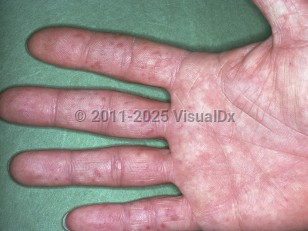Cold agglutinins are usually immunoglobulin M (IgM) antibodies (less commonly IgA or IgG antibodies) that recognize the I antigen (or i antigen in neonates and infants) on RBCs. Primary CAD is often associated with lymphoproliferative bone marrow disorders. It is very rare, with an incidence of about 1 per million in Scandinavian studies. There is a slightly higher prevalence in females, and the median age of diagnosis is approximately 60-70 years, although the range of ages of presentation is very broad (30-90 years). Secondary CAD is due to a viral infection (Epstein-Barr virus [EBV], HIV, influenza, varicella-zoster, or rubella), Mycoplasma pneumoniae infection, autoimmune disease, or lymphoid malignancy. Cold agglutinins cause agglutination of RBCs and extravascular hemolysis.
Donath-Landsteiner antibodies recognize RBC antigens at cold temperatures and fix complement to their surface, causing intravascular hemolysis.
Cryoglobulins are antibodies that form immune complexes and cause vasculitis, vascular occlusion, or systemic inflammatory syndrome.
The presence of cold agglutinins can go unnoticed until the patient is exposed to cold stress. The most common findings include anemia (90% of patients), although of varying degrees of severity and symptomatology, and increased hemolytic markers such as lactate dehydrogenase (LDH), bilirubin, or haptoglobin (90% of patients), but only about half of patients will have cold-induced symptoms (52% in one series but as high as 90% in a series of patients who live in colder climates).
Cold-induced symptoms include:
- Acrocyanosis (bluish-purple discoloration of fingertips, toes, nose, and ears) is the most common finding.
- Raynaud phenomenon, a well-demarcated color change of the digits on exposure to cold.
- Livedo reticularis, a lacy (reticulated), blanching, violaceous rash.
- Cutaneous ulceration or necrosis.
- Pain or discomfort swallowing cold food or liquids.



